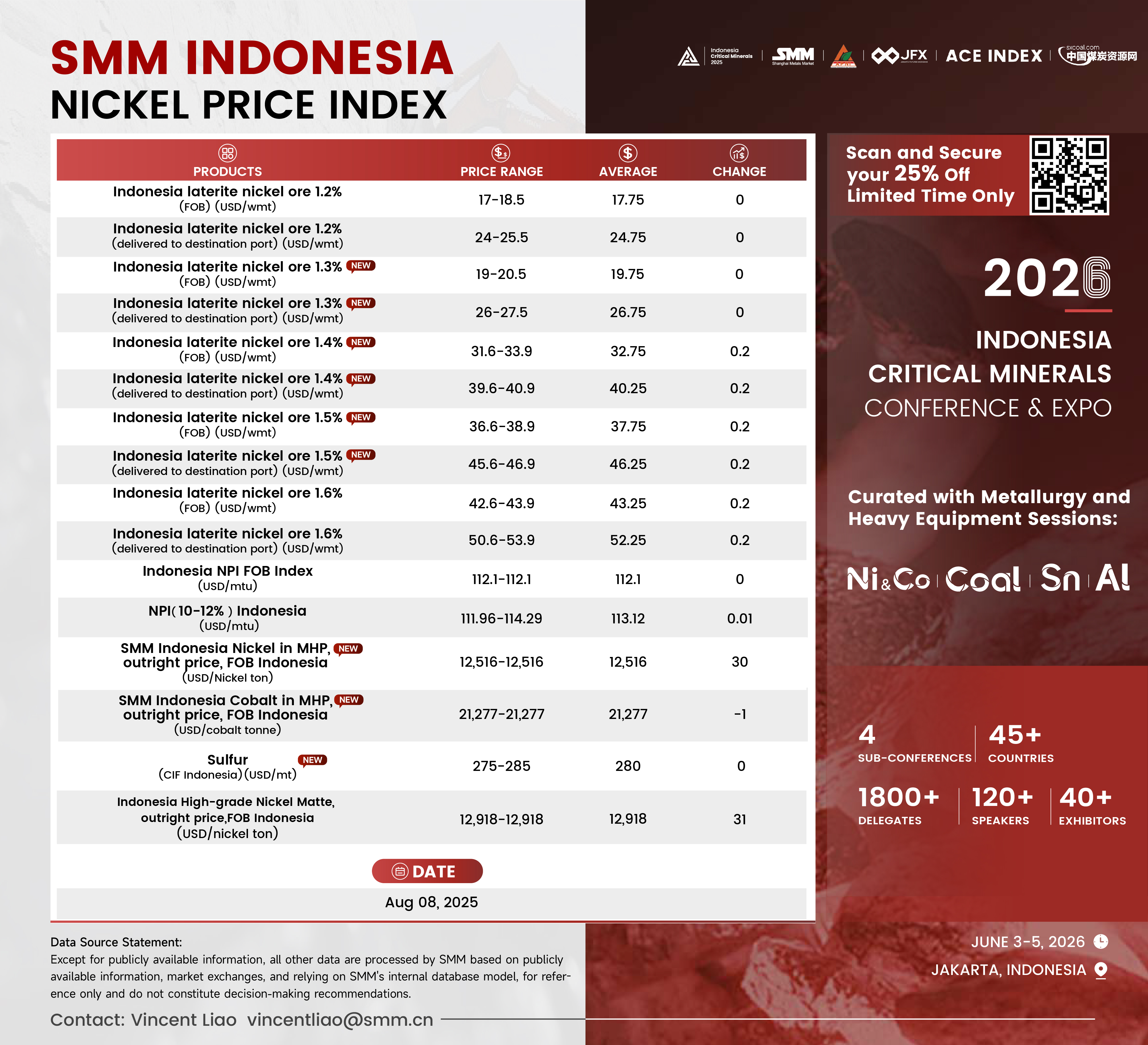






Nickel Ore
"RKAB Policy Reset in 2026? Rainy Season in Parts of Indonesia Shows Noticeable Improve"
Nickel ore prices in Indonesia slightly fluctuates this week. In terms of benchmark prices, Indonesia’s domestic trade benchmark price in the first period of August for nickel ore are rising, reaching USD 15,208/dmt, a 0.69% increase. The mainstream premium for Indonesian laterite nickel ore 1.6% remained at $24–26/wmt. SMM's delivered price for 1.6% laterite nickel ore stood at $50.6–53.9/wmt, a USD0.2 increase compared to last week. Additionally, SMM’s delivered price for 1.3% ore stood at $26–27.5/wmt, unchanged week on week.
On the supply side, Sulawesi's mining regions experienced very little rainfall this week, signalling better conditions overall, although rains still continue in the Halmahera region, which still affects production. These conditions have partially alleviated previous disruptions to mining and transportation activities, potentially supporting a recovery in nickel ore production and overall supply." On the demand side, profit margins for Indonesian smelters have shown marginal improvement, although the issue of cost inversion remains unresolved. Some NPI (Nickel Pig Iron) smelters in Indonesia raised their minimum ore grade requirement this week from 1.45% to 1.5%, which will impose stricter requirements for ore grade. This adjustment is expected to enable more NPI production from the same volume of ore.
In terms of RKAB policy, the Ministry of Energy and Mineral Resources (ESDM) intends to reduce the validity period of mining quotas from the current three years to a single year. Consequently, mining companies will be required to reapply for RKAB quotas in October if the official regulation is released. This regulatory uncertainty has prompted both smelters and mining operators to adopt a cautious, wait-and-see stance toward current market prices. Given the ongoing losses at smelters and the gradual issuance of supplementary RKAB quotas, the price of pyrometallurgical-grade nickel ore still faces downward pressure.
From the supply side, The market is showing slight oversupply due to progress on RKAB quota approvals, which could induce increased ore production. Several HPAL smelters have not yet shown signs of tight supply. No significant increase in demand from Indonesian smelters this week. In the short term, newly built HPAL projects in Indonesia have not yet begun nickel ore procurement, and smelter inventories remain stable. Looking ahead, downstream smelter's demand remain relatively stable, and with most 2025 RKAB quotas gradually being approved, hydrometallurgical ore prices are expected to stay weak.
NPI
"Supply-Demand Mismatch Persists, Price Gap Between Chinese and Indonesian NPI Widens"
The average price of SMM 8–12% high-grade NPI rose by RMB 10.8 per nickel point from last week to RMB 917 per nickel point (ex-works, including tax). Meanwhile, the FOB price index for Indonesian NPI increased by $1.2 per nickel point to $111.84 per nickel point compared to last week. This week, SHFE nickel and stainless steel futures remained stable. Amid ongoing losses, cost support for smelters became more pronounced, pushing up their quotations, with trading prices among traders also trending higher. Despite stable SHFE nickel and stainless steel futures, cost support from smelters—driven by ongoing losses—prompted higher price quotations and tighter supply, as upstream producers held back shipments in anticipation of better prices. Although Q3 is expected to bring increased Indonesian supply, volumes remain limited for now, though port arrivals have recently picked up. Demand remains cautious due to continued supply-demand mismatch, with downstream buyers mainly referencing average prices or landed costs of Indonesian NPI. The price gap between domestic and imported NPI is widening, and the overall market remains in a deadlock, with limited actual transactions.
Meanwhile, the price discount between high-grade NPI and refined nickel narrowed to RMB 293.8 per ton, and is expected to shrink further as NPI prices rise and refined nickel stays firm. Due to the economic advantage of MHP over high-grade nickel matte, the shift from NPI to matte remains limited. On the cost side, smelters are still under pressure as auxiliary material costs have increased despite low Philippine nickel ore prices, keeping many producers in a loss-making position. Looking ahead, auxiliary costs may stabilize and another downfall of nickel ore prices remains limited, meaning smelter cost lines should remain steady. As NPI prices continue to climb, smelter margins could gradually improve.

For queries, please contact Lemon Zhao at lemonzhao@smm.cn
For more information on how to access our research reports, please email service.en@smm.cn